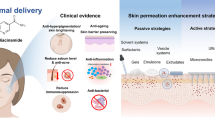Abstract
To develop effective and safe penetration enhancers, a series of l-carvyl esters, namely, 5-isopropenyl-2-methylcyclohex-2-en-1-yl heptanoate (C-HEP), 5-isopropenyl-2- methylcyclohex-2-en-1-yl octanoate (C-OCT), 5-isopropenyl-2-methylcyclohex-2-en-1-yl decanoate (C-DEC), 5-isopropenyl-2-methylcyclohex-2-en-1-yl dodecanoate (C-DOD), 5-isopropenyl-2-methylcyclohex-2-en-1-yl tetradecanoate (C-TET), and 5-isopropenyl-2-methylcyclohex-2-en-1-yl palmitate (C-PAL), was synthesized from l-carveol and saturated fatty acids (C7–C16). The volatility of l-carveol and l-carvyl esters was evaluated by a live weight loss experiment. The enhancing effects of l-carvyl esters on 5-fluorouracil (FU) were investigated in the in vitro permeation experiment on rat skin. The stratum corneum (SC) uptakes of the enhancers were tested in vitro by gas chromatography. Only the l-carvyl esters with a moderate SC uptake, namely, C-OCT (C8), C-DEC (C10), and C-DOD (C12), showed a potential to enhance FU skin permeation. An evident parabolic relationship was found between the permeation enhancement of FU and the SC uptake of the l-carvyl esters. The l-carvyl esters with a chain length of C8–C12 seemed to be favorable for FU.




Similar content being viewed by others
REFERENCES
Prausnitz MR, Langer R. Transdermal drug delivery. Nat Biotechnol. 2008;26:1261–8.
Swain S, Beg S, Singh A, Patro Ch N, Rao ME. Advanced techniques for penetration enhancement in transdermal drug delivery system. Curr Drug Deliv. 2011;8:456–73.
Thakur RA, Wang Y, Michniak BB. Essential oils and terpenes. In: Smith EW, Maibach HI, editors. Percutaneous penetration enhancers. 2nd ed. Boca Raton: CRC Press; 2005. p. 159–73.
Bhatia SP, McGinty D, Letizia CS, Api AM. Fragrance material review on laevo-carveol. Food Chem Toxicol. 2008;46:S88–90.
Magnusson BM, Runn P, Karlsson K, Koskinen LOD. Terpenes and ethanol enhance the transdermal permeation of the tripeptide thyrotropin releasing hormone in human epidermis. Int J Pharm. 1997;157:113–21.
Magnusson BM, Runn P, Karlsson K, Koskinen LOD. Terpene-enhanced transdermal permeation of water and ethanol in human epidermis. Acta Derm Venereol. 1997;77:264–7.
Williams AC, Barry BW. Terpenes and the lipid-protein-partitioning theory of skin penetration enhancement. Pharm Res. 1991;8:17–24.
Vávrová K, Hrabálek A, Dolezal P, Sámalová L, Palát K, Zbytovská J. Synthetic ceramide analogues as skin permeation enhancers: structure-activity relationships. Bioorg Med Chem. 2003;11:5381–90.
Zhao L, Fang L, Xu Y, Liu S, He Z, Zhao Y. Transdermal delivery of penetrants with differing lipophilicities using O-acylmenthol derivatives as penetration enhancers. Eur J Pharm Biopharm. 2008;69:199–213.
Zhao L, Fang L, Xu Y, Zhao Y, He Z. Effect of O-acylmenthol on transdermal delivery of drugs with different lipophilicity. Int J Pharm. 2008;352:92–103.
Hadgraft J, Lane ME. Skin permeation: the years of enlightenment. Int J Pharm. 2005;305:2–12.
Hathout RM, Mansour S, Mortada ND, Geneidi AS, Guy RH. Uptake of microemulsion components into the stratum corneum and their molecular effects on skin barrier function. Mol Pharm. 2010;7:1266–73.
Morimoto K, Tojima H, Haruta T, Suzuki M, Kakemi M. Enhancing effects of unsaturated fatty acids with various structures on the permeation of indomethacin through rat skin. J Pharm Pharmacol. 1996;48:1133–7.
Liu R, Liu ZD, Zhang CG, Zhang BL. Gelucire44/14 as a novel absorption enhancer for drugs with different hydrophilicities: in vitro and in vivo improvement on transcorneal permeation. J Pharm Sci. 2011;100:3186–95.
Liu JJ, Fu SY, Wei N, Hou YS, Zhang XN, Cui H. The effects of combined menthol and borneol on fluconazole permeation through the cornea ex vivo. Eur J Pharmacol. 2012;688:1–5.
Santos P, Watkinson AC, Hadgraft J, Lane ME. Influence of penetration enhancer on drug permeation from volatile formulations. Int J Pharm. 2012;439:260–8.
He N, Warner KS, Chantasart D, Shaker DS, Higuchi WI, Li SK. Mechanistic study of chemical skin permeation enhancers with different polar and lipophilic functional groups. J Pharm Sci. 2004;93:1415–30.
Ibrahim SA, Li SK. Effects of chemical enhancers on human epidermal membrane: structure-enhancement relationship based on maximum enhancement (E(max)). J Pharm Sci. 2009;98:926–44.
Trommer H, Neubert RH. Overcoming the stratum corneum: the modulation of skin penetration. Skin Pharmacol Physiol. 2006;19:106–21.
Williams AC, Barry BW. Penetration enhancers. Adv Drug Deliv Rev. 2004;56:603–18.
Krevelen V, Krevelen DW. Properties of polymers. Amsterdam: Elsevier, Sci. Publ. Co.; 1990.
ACKNOWLEDGMENTS
This work was supported by the National Natural Science Foundation of China (no. 30973654) and Research Fund for the Doctoral Program of Higher Education of China (no. 20092134110002).
Author information
Authors and Affiliations
Corresponding author
Rights and permissions
About this article
Cite this article
Wang, M., Xi, H., Cun, D. et al. l-Carvyl Esters as Penetration Enhancers for the Transdermal Delivery of 5-Fluorouracil. AAPS PharmSciTech 14, 669–674 (2013). https://doi.org/10.1208/s12249-013-9952-2
Received:
Accepted:
Published:
Issue Date:
DOI: https://doi.org/10.1208/s12249-013-9952-2




